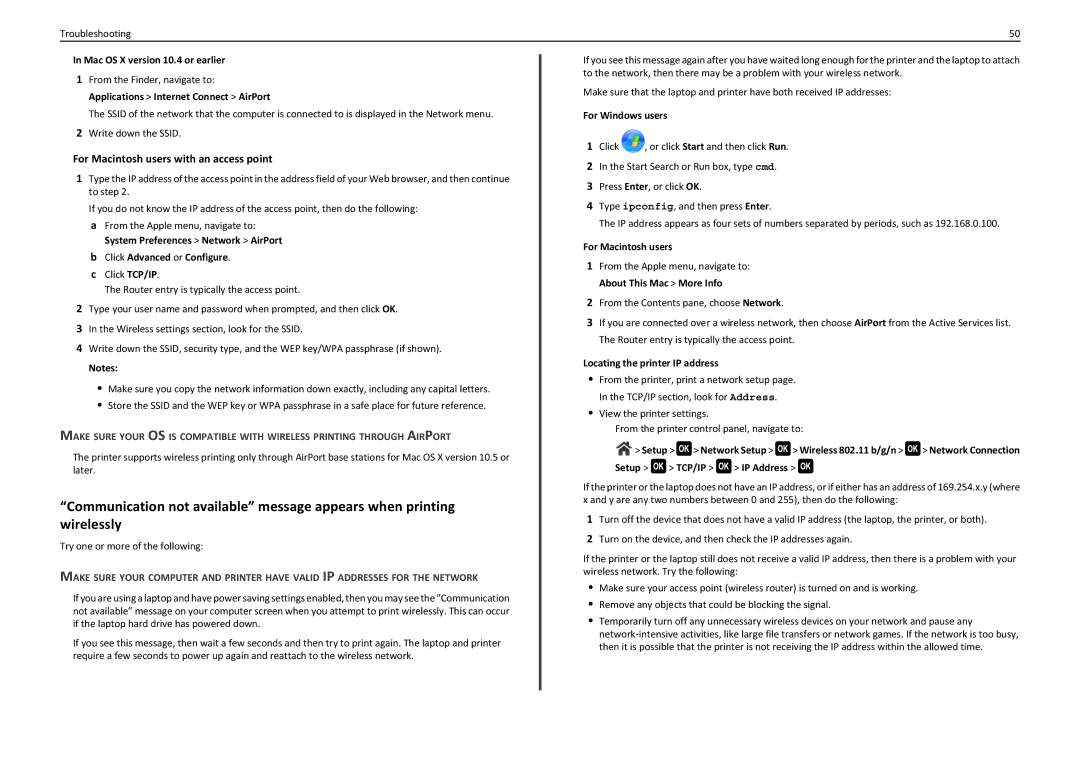
Troubleshooting | 50 |
In Mac OS X version 10.4 or earlier
1From the Finder, navigate to: Applications > Internet Connect > AirPort
The SSID of the network that the computer is connected to is displayed in the Network menu.
2Write down the SSID.
For Macintosh users with an access point
1Type the IP address of the access point in the address field of your Web browser, and then continue to step 2.
If you do not know the IP address of the access point, then do the following:
aFrom the Apple menu, navigate to: System Preferences > Network > AirPort
bClick Advanced or Configure.
cClick TCP/IP.
The Router entry is typically the access point.
2Type your user name and password when prompted, and then click OK.
3In the Wireless settings section, look for the SSID.
4Write down the SSID, security type, and the WEP key/WPA passphrase (if shown).
Notes:
•Make sure you copy the network information down exactly, including any capital letters.
•Store the SSID and the WEP key or WPA passphrase in a safe place for future reference.
MAKE SURE YOUR OS IS COMPATIBLE WITH WIRELESS PRINTING THROUGH AIRPORT
The printer supports wireless printing only through AirPort base stations for Mac OS X version 10.5 or later.
“Communication not available” message appears when printing wirelessly
Try one or more of the following:
MAKE SURE YOUR COMPUTER AND PRINTER HAVE VALID IP ADDRESSES FOR THE NETWORK
If you are using a laptop and have power saving settings enabled, then you may see the ”Communication not available” message on your computer screen when you attempt to print wirelessly. This can occur if the laptop hard drive has powered down.
If you see this message, then wait a few seconds and then try to print again. The laptop and printer require a few seconds to power up again and reattach to the wireless network.
If you see this message again after you have waited long enough for the printer and the laptop to attach to the network, then there may be a problem with your wireless network.
Make sure that the laptop and printer have both received IP addresses:
For Windows users
1Click ![]() , or click Start and then click Run.
, or click Start and then click Run.
2In the Start Search or Run box, type cmd.
3Press Enter, or click OK.
4Type ipconfig, and then press Enter.
The IP address appears as four sets of numbers separated by periods, such as 192.168.0.100.
For Macintosh users
1From the Apple menu, navigate to: About This Mac > More Info
2From the Contents pane, choose Network.
3If you are connected over a wireless network, then choose AirPort from the Active Services list. The Router entry is typically the access point.
Locating the printer IP address
•From the printer, print a network setup page. In the TCP/IP section, look for Address.
•View the printer settings.
From the printer control panel, navigate to:
![]() > Setup >
> Setup >![]() > Network Setup >
> Network Setup >![]() > Wireless 802.11 b/g/n >
> Wireless 802.11 b/g/n >![]() > Network Connection
> Network Connection
Setup > ![]() > TCP/IP >
> TCP/IP > ![]() > IP Address >
> IP Address > ![]()
If the printer or the laptop does not have an IP address, or if either has an address of 169.254.x.y (where x and y are any two numbers between 0 and 255), then do the following:
1Turn off the device that does not have a valid IP address (the laptop, the printer, or both).
2Turn on the device, and then check the IP addresses again.
If the printer or the laptop still does not receive a valid IP address, then there is a problem with your wireless network. Try the following:
•Make sure your access point (wireless router) is turned on and is working.
•Remove any objects that could be blocking the signal.
•Temporarily turn off any unnecessary wireless devices on your network and pause any
network‑intensive activities, like large file transfers or network games. If the network is too busy, then it is possible that the printer is not receiving the IP address within the allowed time.
